

Marco works on cubical n-categories and directed algebraic topology.
Experts will recognize Mark Weber's impressive head in the background.
July 5, 2008
Having spent a little time wandering the
old neighborhoods
of Beijing, this book appeals to me:
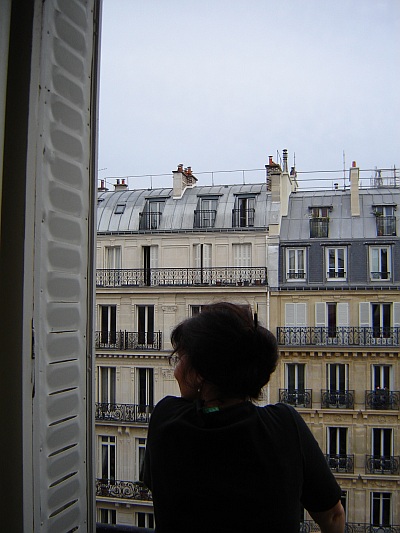

In the other direction, at street level, you can see the Jardin du Luxembourg, with the Eiffel Tower peeping above the trees:
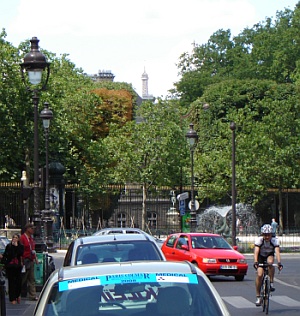
The street itself is sometimes bustling with tourists, sometimes calm; there's an Italian ice cream store next to our front door. After a hotel room in Granada with a view of the Alhambra and this marvelous apartment in Paris, I can't help but feel it's all downhill from here. Did you ever get the feeling you're too lucky, and bound to pay for it later? The mortgage crisis, spiralling oil prices, and fires in California add to this sensation. I may look back on this as a charmed moment...
But no time for idle guilt today: I had to find the 89 bus to the monstrous towers of the Bibliothèque nationale de France and then an obscure location in Paris 7, where I gave a talk on Computation and the Periodic Table at a conference on Algebraic Topological Methods in Computer Science. I met my host at Paris 7, Paul-André Melliès. I also met Eugenia Cheng, Marco Grandis, Yves Lafont, Tim Porter and Mark Weber, all of whome had come from Barcelona. Sometimes I feel like part of a travelling circus troupe.
The conference was in a horrible concrete building that resembled a parking garage, with some walls painted orange. But, we made the best of it:
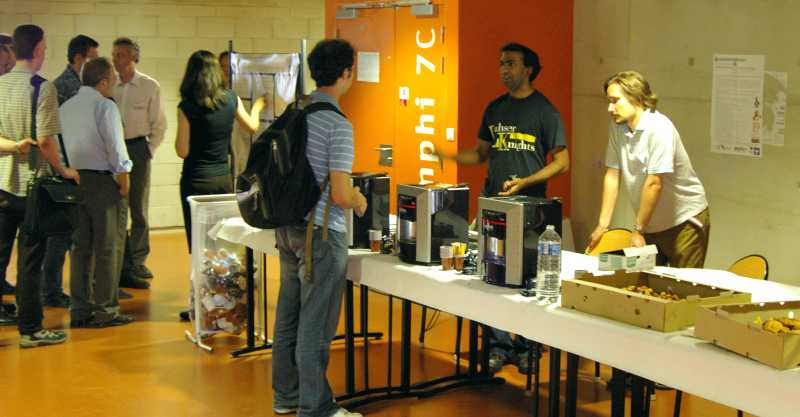
Later, Eugenia and I had a long
talk on Steve Lack's paper on composing PROPs; you can see some of the results in
a post at the
n-Category Café.
July 13, 2008
Today I flew to Lisbon for agregãço of
Alexsandar
Mikovic,
who works on spin foam models of quantum gravity.
An agregãço is a bit like what the Germans call a "habilitation":
a further step after the doctorate. In Portugal you need to
pass the agregãço to become a full professor.
I met Roger Picken
and Louis Kauffman
at my hotel just as I was checking in, and we went out to dinner.
It reminded me a bit of the early 90's, when I went to Porto for Pickens'
conferences on topological quantum field theory. I never
met Kauffman at one of those, but we both often met Louis Crane
and other mutual friends. Those were the heady early days of
quantum topology, when higher categories first met physics.
July 14, 2008
In the morning
Louis Kauffman gave a talk on virtual knot theory
and I gave a talk on
classifying spaces for topological 2-groups.
In the afternoon we carried out the first phase of the
agregãço, which required that Kauffman read Mikovic's resume and
comment on it. Mikovic sat in a chair below while Kauffman and the other
members of the jury sat on a raised stage behind a long table.
Kauffman and I had dinner and talked math. I'd like to understand the category theory underlying virtual knot theory. Abstractly, it seems to concern the free symmetric monoidal category on one object equipped X with a morphism R: X ⊗ X → X ⊗ X that satisfies the Yang-Baxter equation. This gives our category a braiding in addition to the original symmetry. We draw the new braiding as a crossing, and the original one as a "virtual crossing".
July 15, 2008
In the morning I had nice conversations with
João
Faria Martins and his wife
Rachel
Martins. I later wrote about João's work on
week267, and I should learn about Rachel's
work on double Fell bundles and write about that too.
In the afternoon we completed the agregãço, with Mikovic giving a talk on his research and me asking questions about it.
I should tell you about the weather in California! The snow pack in the Sierras started out promising this year, at least compared to last — and we had some nice rains down in Riverside. But overall, it fell short of the average:
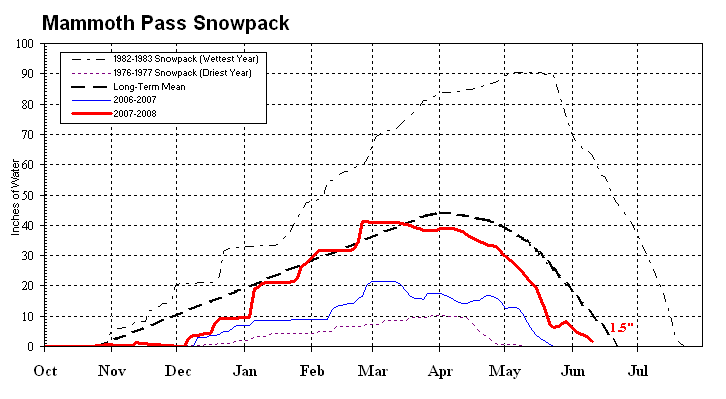
California Wildfires Set a Record
Mike Nizza, New York Times
July 15, 2008
Three weeks after lightning storms ignited an early start to California's wildfire season, a state official said history had been made this time around. From The Los Angeles Times:
“That has definitely surpassed any of our large fire events,” said Daniel Berlant, a spokesman for the California Department of Forestry and Fire Protection.
According to statistics from Mr. Berlant's agency, as many as 1,781 fires were burning at one point earlier in the battle; nearly 300 of them remain unquenched. In all, 861,385 acres were scorched by them, mostly in the northern part of the state. (A map shows where).
Because this year's fires were mainly in sparsely populated rural areas, the biggest fire season has by no means been the most destructive, at least so far. Last year's wildfires in southern California prompted the “largest evacuation in California's history” and destroyed at least 1,800 homes.
By contrast, this year's batch has mostly torn through forests, claiming only about 100 homes and prompting evacuation orders on a much smaller scale. Still, several populated areas did come under threat, including Big Sur, the mostly high-end tourist destination on the central coast. It was cleared in early July after a stubborn fire intensified.
Ladies and gentlemen:Today Lisa and I went to the Musée du Cluny, which is very close by. A real gem! I enjoyed the special exhibit on Islamic art and its influence on Spain, borrowed from the Louvre, but the permanent collections were also great. The symbolism of the Lady and Unicorn tapestries was much more complex and interesting than I'd suspected. Almost like a Buddhist metaphor of transcending the senses.There are times in the history of our nation when our very way of life depends upon dispelling illusions and awakening to the challenge of a present danger. In such moments, we are called upon to move quickly and boldly to shake off complacency, throw aside old habits and rise, clear-eyed and alert, to the necessity of big changes. Those who, for whatever reason, refuse to do their part must either be persuaded to join the effort or asked to step aside. This is such a moment. The survival of the United States of America as we know it is at risk. And even more — if more should be required — the future of human civilization is at stake.
I don't remember a time in our country when so many things seemed to be going so wrong simultaneously. Our economy is in terrible shape and getting worse, gasoline prices are increasing dramatically, and so are electricity rates. Jobs are being outsourced. Home mortgages are in trouble. Banks, automobile companies and other institutions we depend upon are under growing pressure. Distinguished senior business leaders are telling us that this is just the beginning unless we find the courage to make some major changes quickly.
The climate crisis, in particular, is getting a lot worse — much more quickly than predicted. Scientists with access to data from Navy submarines traversing underneath the North polar ice cap have warned that there is now a 75 percent chance that within five years the entire ice cap will completely disappear during the summer months. This will further increase the melting pressure on Greenland. According to experts, the Jakobshavn glacier, one of Greenland's largest, is moving at a faster rate than ever before, losing 20 million tons of ice every day, equivalent to the amount of water used every year by the residents of New York City.
Two major studies from military intelligence experts have warned our leaders about the dangerous national security implications of the climate crisis, including the possibility of hundreds of millions of climate refugees destabilizing nations around the world.
Just two days ago, 27 senior statesmen and retired military leaders warned of the national security threat from an "energy tsunami" that would be triggered by a loss of our access to foreign oil. Meanwhile, the war in Iraq continues, and now the war in Afghanistan appears to be getting worse.
And by the way, our weather sure is getting strange, isn't it? There seem to be more tornadoes than in living memory, longer droughts, bigger downpours and record floods. Unprecedented fires are burning in California and elsewhere in the American West. Higher temperatures lead to drier vegetation that makes kindling for mega-fires of the kind that have been raging in Canada, Greece, Russia, China, South America, Australia and Africa. Scientists in the Department of Geophysics and Planetary Science at Tel Aviv University tell us that for every one degree increase in temperature, lightning strikes will go up another 10 percent. And it is lightning, after all, that is principally responsible for igniting the conflagration in California today.
Like a lot of people, it seems to me that all these problems are bigger than any of the solutions that have thus far been proposed for them, and that's been worrying me...
Yet when we look at all three of these seemingly intractable challenges at the same time, we can see the common thread running through them, deeply ironic in its simplicity: our dangerous over-reliance on carbon-based fuels is at the core of all three of these challenges — the economic, environmental and national security crises.
We're borrowing money from China to buy oil from the Persian Gulf to burn it in ways that destroy the planet. Every bit of that's got to change...
But if we grab hold of that common thread and pull it hard, all of these complex problems begin to unravel and we will find that we're holding the answer to all of them right in our hand.
The answer is to end our reliance on carbon-based fuels.
I also didn't know they used dodecahedral dice in the Middle Ages. Lisa took this picture, which I may add to my talk on the dodecahedron someday:
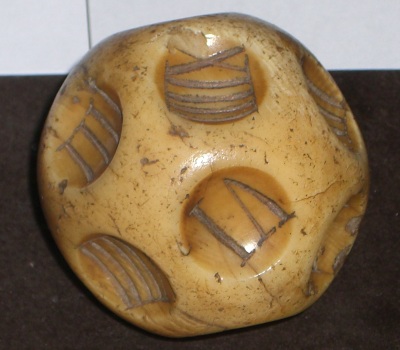
July 18, 2008
I was quoted in this article about a very tricky subject, namely
the vacuum:
I was also quoted in the same issue of New Yorker magazine that featured a controversial cartoon of Barack Obama and his wife on the front cover. This was for an article on Garrett Lisi and his much-hyped "theory of everything" based on the group E8. My quote wasn't anything I actually said, but I'd failed to veto it forcefully enough at the fact-checking stage.
Lisa and I went shopping at the open-air market at the east end of Saint-Germain. It turns out they still eat horses in Paris, though the history of this practice is a bit obscure:
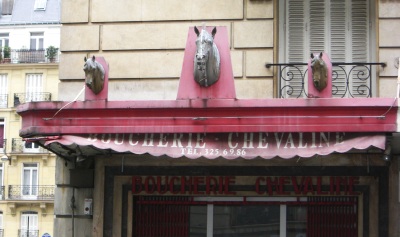
But, we didn't buy any horse meat. Instead we bought the makings for a particularly charming dinner of leek soup, frisée salad, sausage and chèvre, backed by a baguette.

Great ingredients make for great simple meals — that's
the way of Provençal cooking.
Another tradition, of fancy Parisian cuisine with
lots of sauces, apparently arose as a way of dealing with
food that was beginning to go bad.
July 23, 2008
Paul-André organized a little microconference at Paris 7
today:
To add to the stew, my former student (if I may
call him that) Aaron Lauda has obtained Frobenius pseudomonoids from
categorified ambidextrous adjunctions, and related both of these to
3d topology.
I think I see a glimpse of some wonderful patterns, very
tantalizing because I don't quite understand them.
July 27, 2008
We had Henry Crapo and a friend of his over for dinner.
Henry is an expert on incidence geometry who has worked with my
pal Bill Schmitt on using
Hopf algebras to study
matroids. He has a large house in Montpellier, and he's
thinking of holding an informal conference next summer on Hopf
algebras in quantum field theory... or something like that.
After dinner we walked over to the Île de Saint-Louis to get ice cream at our favorite place: Berthillon's. They've got some far-out-flavors: I had a scoop of the praline-and-coriander. Yum! Sounds weird, but it's great.
The Île de Saint-Louis is one of two islands in the Seine right in the heart of Paris. On our way back home we took a bridge over to the other: the le de la Cité. This is the site of the Notre Dame cathedral, always packed with tourists. Henry led us down some steps to a plaque commemorating Jacques de Molay, the last Grand Master of the Knights Templar, who was burned at the stake on the Île de la Cité in 1314.
Here's one of those views every visitor to Paris sees:
July 30, 2008
As I get older, I'm more susceptible to the charm of nostalgia for old
technology. Imagine the days when letters were sent using pigeons!
They were the fastest method of sending a message from at least
2900 BC
to the invention of the telegraph in 1844.
From Wikipedia:
Before the telegraph this method of communication had a considerable vogue amongst stockbrokers and financiers. The Dutch government established a civil and military system in Java and Sumatra early in the 19th century, the birds being obtained from Baghdad. In 1851, the German-born Paul Julius Reuter opened an office in the City of London which transmitted stock market quotations between London and Paris via the new Calais to Dover cable. Reuter had previously used pigeons to fly stock prices between Aachen and Brussels, a service that operated for a year until a gap in the telegraph link was closed.Here in Paris, let us take this moment to salute the brave pigeons that defended this city against the Germans and their hawks during the Franco-Prussian war!Details of the employment of pigeons during the siege of Paris in 1870-71 led to a revival in the training of pigeons for military purposes. Numerous societies were established for keeping pigeons of this class in all important European countries; and, in time, various governments established systems of communication for military purposes by pigeon post. After pigeon post between military fortresses had been thoroughly tested, attention was turned to its use for naval purposes, to send messages to ships in nearby waters. It was also used by news agencies and private individuals at various times. Governments in several countries established lofts of their own. Laws were passed making the destruction of such pigeons a serious offense; premiums to stimulate efficiency were offered to private societies, and rewards given for destruction of birds of prey. Before the advent of radio, pigeons were used by newspapers to report yacht races, and some yachts were actually fitted with lofts.
During the establishment of formal pigeon post services, the registration of all birds was introduced. At the same time, in order to hinder the efficiency of the systems of foreign countries, difficulties were placed in the way of the importation of their birds for training, and in a few cases falcons were specially trained to interrupt the service war-time, the Germans having set the example by employing hawks against the Paris pigeons in 1870-71. No satisfactory method of protecting the weaker birds seems to have been developed, though the Chinese formerly provided their pigeons with whistles and bells to scare away birds of prey. However, as radio telegraphy and telephony were developed, the use of pigeons became limited to fortress warfare as early as in the 1910s. As an example, the British Admiralty discontinued its pigeon service in the early 20th century, although it had attained a remarkably high standard of efficiency. Nevertheless, large numbers of birds were still kept at the great inland fortresses of France, Germany and Russia at the outbreak of the First World War.
The pigeon post which was in operation while Paris was besieged during the Franco-Prussian War of 1870-1871 is probably the most famous. Barely six weeks after the outbreak of hostilities, the Emperor Napoleon III and the French Army of Chalons surrendered at Sedan on 2nd September 1870. There were two immediate consequences: the fall of the Second Empire and the swift Prussian advance on Paris. As had been expected, the normal channels of communication into and out of Paris were interrupted during the four-and-a-half months of the siege, and, indeed, it was not until the middle of February 1871 that the Prussians relaxed their control of the postal and telegraph services. With the encirclement of the city on 18th September, the last overhead telegraph wires were cut on the morning of 19th September, and the secret telegraph cable in the bed of the Seine was located and cut on 27th September. Although a number of postmen succeeded in passing through the Prussian lines in the earliest days of the siege, others were captured and shot, and there is no proof of any post, certainly after October, reaching Paris from the outside, apart from private letters carried by unofficial individuals. For an assured communication into Paris, the only successful method was by the time-honoured carrier-pigeon, and thousands of messages, official and private, were thus taken into the besieged city.
Here's a poem by John Ashbery:
These are amazing: each
Joining a neighbor, as though speech
Were a still performance.
Arranging by chance
To meet as far this morning
From the world as agreeing
With it, you and I
Are suddenly what the trees try
To tell us we are:
That their merely being there
Means something; that soon
We may touch, love, explain.
And glad not to have invented
Some comeliness, we are surrounded:
A silence already filled with noises,
A canvas on which emerges
A chorus of smiles, a winter morning.
Place in a puzzling light, and moving,
Our days put on such reticence
These accents seem their own defense.
The hand holds no chalk
And each part of the whole falls off
And cannot know it knew, except
Here and there, in cold pockets
Of remembrance, whispers out of time. - John Ashbery
© 2008 John Baez
baez@math.removethis.ucr.andthis.edu